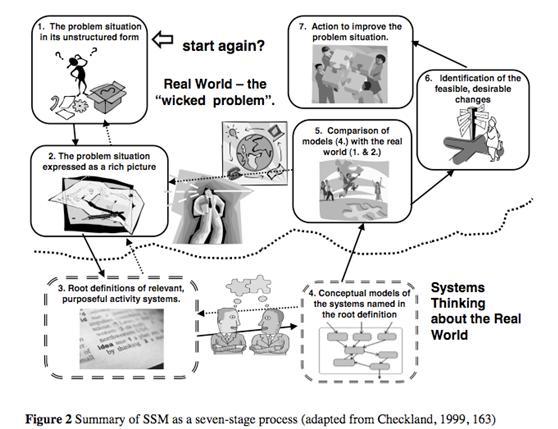This is a critique of a theoretical Paper “Information Systems and Systems – Thinking: Time to Unite?” (Checkland, 1988) which is concerning itself about the systems design for an organisation and challenging the classical system design as predominate from the 1950s/1960s.
At first, the transformation from data to information is reviewed and how this process is unique in every human due to his one perception. The article continues with the naming of Turing and Neumann of computer actions and how they do not match up to the actions associated in humans, which seems not to be to the point of the topic of information and systems design that the article is ultimately trying to discuss. In the next chapter the primary development of the information theory of 1940 is reviewed and the key issue stated, that the systems cannot distinguish the signals to enhance “information” and a not helping voicing of the “confusion” in the field is added, as it followed by a figure which is only explained much later in the text. The figure 1 and 2 explain the perceived reality and how they related to the vires concepts and envisioned systems which overall help to digest the points made, however the five-line long rant that L. Von Bertalanffy should have used a neologism is yet again confusing in the hard to follow details as they do not relate to the content presented and reduce overall crispiness/ intelligibility. Only on page 5 the objective that should be developed further, the “hard systems” is presented in a short quote which is easily digestible, showing the “means to an end schema”. Ideas of natural systems and designed systems are quickly reviewed and the statement is made, that such systems today should better be replaced with a Soft systems methodology, at least as a starting point for systems design, as this can consider the initial discussed human in a “human activity system”. Why he had to bring in the German word “Weltanschauung” instead of keeping the native English “world view” cannot be comprehended by myself, it would stay the same Acronym (CATWOE) in his seven step process shown in figure 3; Unfortunately the figure 3 misses any directions on how to move through the several steps and only in 1999 Checkland delivers such steps, however the best illustration to the authors’ view is the recent one from (Tayyab, D Finegan, & Walker, 2001):

The conclusion is that there will be more SSM than hard system, which the author cannot share from his professional experience; however, it would be good to further develop the methodology (like suggested by Bergvall-Kåreborn, Mirijamdotter, & Basden (2018)) as there are clear advances challenging given “hard system” borders and combining all perceived realities/purposes of an organisation. In some cases, it could be said the idea of “self-service IT” has already been established, like in a Microsoft SharePoint, which is available in many companies to all their employees where they can manage their data, put it into information and adjust the system anytime themselves as need. In “Five case studies applying soft systems methodology to knowledge management” by (Tayyab, D Finegan, & Walker, 2001) the soft system proves to be worthy in a situation where the scope of a project is not clear from the start and iterations of the system creation proof to be helpful.
However, SSM failed to be widespread, despite large organisations who deal with complex issues / projects on a daily basis as (Jorstad, 2014) analysed and hinting to the economic situation and the low risks organisations tend to take currently in problem/issue solution.
The overall article relates to the newer humanist or interpretive social theory in information systems (Houghton & Ledington, 2002) and as such it is important to try to apply the suggested action of an SSM information management in complex situations, also the author thinks, and Checkland himself suggested, daily and static I.S. would still be “hard systems”. For institutes working in the natural science (like a museum), they could root definitions and identify actions to improve their situation.
References
Bergvall-Kåreborn, B., Mirijamdotter, A., & Basden, A. (2018). REFLECTIONS ON CATWOE, A SOFT SYSTEMS METHODOLOGY TECHNIQUE FOR SYSTEMS DESIGN. researchgate.net. Retrieved from https://www.researchgate.net/publication/251449046_REFLECTIONS_ON_CATWOE_A_SOFT_SYSTEMS_METHODOLOGY_TECHNIQUE_FOR_SYSTEMS_DESIGN
Checkland, P. (1988). Information Systems and Systems – Thinking: Time to Unite? International Journal of Information Management , 239-248.
Houghton, L., & Ledington, P. (2002). The Evolution of Confusion: Soft Systems Methodology and Social Theory revisited. Australian Journal of Information Systems. Retrieved from https://pdfs.semanticscholar.org/3293/64a80ae1a04b3f9bff40f9c9a45445806bca.pdf
Jorstad, J. (. (2014). SSM provides important advantages; so, Why has SSM failed to achieve greater market share? Solid State Phenomena, Vols. 217-218, pp. 481-486. doi:https://doi.org/10.4028/www.scientific.net/SSP.217-218.481
Tayyab, M., D Finegan, A., & Walker, D. (2001). Five case studies applying soft systems methodology to knowledge management. 2001: Icon.Net Pty Ltd. Retrieved from http://eprints.qut.edu.au/27456/
